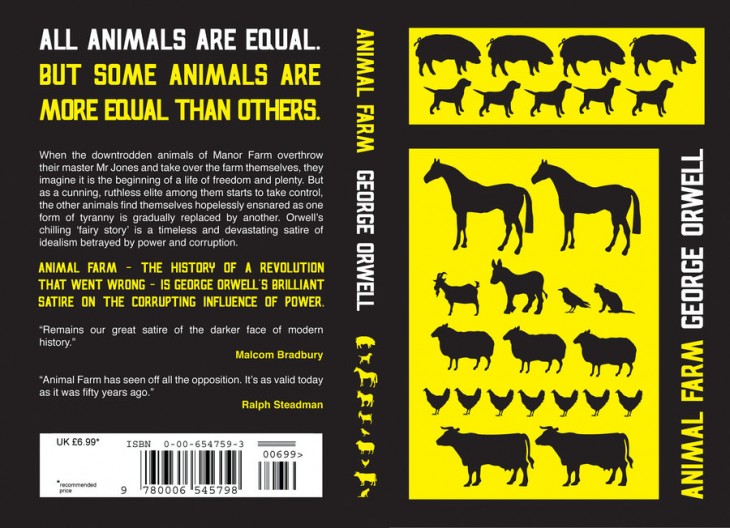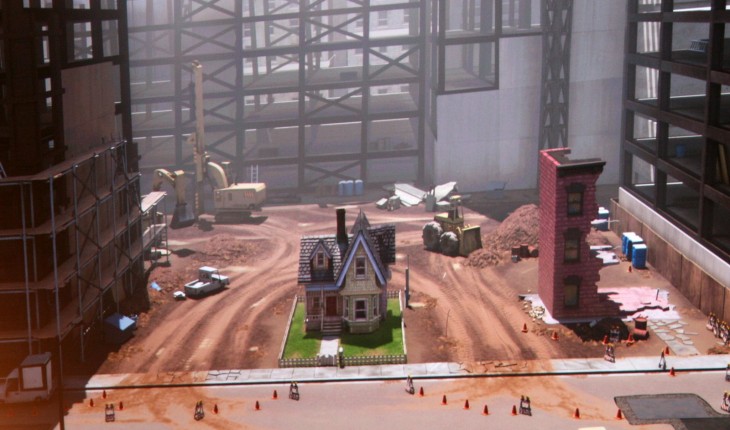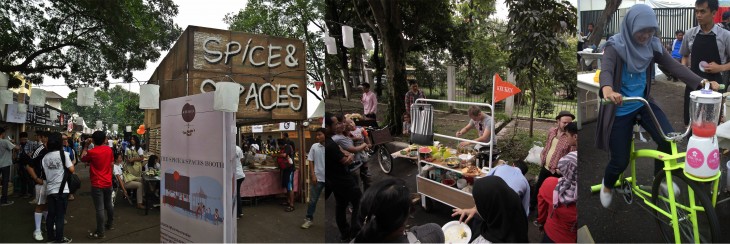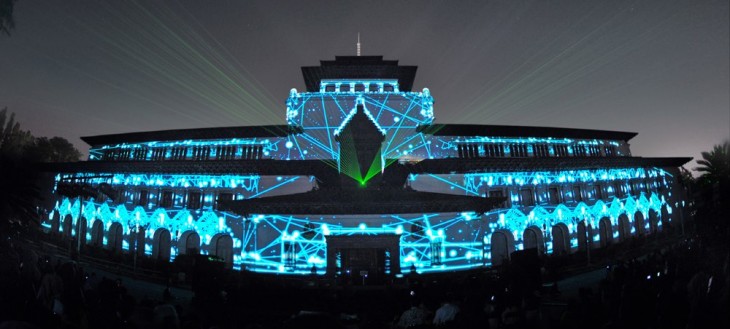Disputes between people over power has been distracting my understanding about what actually caused economy and socio culture issues. Not yet to mention about the role of architecture and design in it, I want to express that I believe this harmonised/unharmonised relations between all aspects and disciplines in urban level are caused by power and people who have it. It is a cynical way to say, but a top down effect has always been what I can see and experience, specially in my developing country.
 Book: ANIMAL FARM by George Orwell (1945). Source: http://mattcantdraw.deviantart.com/art/Animal-Farm-Cover-256002330
Book: ANIMAL FARM by George Orwell (1945). Source: http://mattcantdraw.deviantart.com/art/Animal-Farm-Cover-256002330
Bandung is the second largest city in Indonesia after the capital city, Jakarta. It is the capital city of one of the main provinces with over than 2.9 million inhabitants. Most of the population is young generation, over than 70% is under 40 years old. Several aspects that are the magnets of the city are culinary, product designs (fashion, home decor, etc) music scenes, creative and innovative gatherings/workshops, art and new media exhibition, and many other things that are closely related to creativity, design, and art, practically, and most of the generators are start ups or self employed. The city is so driven by people’s initiative that perhaps my believe that I mentioned in my first paragraph should be questioned.
Yet, Bandung has no decent infrastructure, it has disorganised urban plan, and regular citizen sometimes get crushed by big corporates in architecture matter.
 Movie: UP by Pixar (2009). Source: http://www.topbackground.com/up-movie-ballon-3652-hd-wallpaper-pictures
Movie: UP by Pixar (2009). Source: http://www.topbackground.com/up-movie-ballon-3652-hd-wallpaper-pictures
The city is surviving until now and growing, people (mostly) are happy and still manage to develop and improve their interests that shape the whole city itself. Then my question is, would Bandung be New York if the city/urban infrastructure were a top notch support system for its citizens?
Bandung has 3 main potentials that shape its creative traits; People, Ideas, and Place. Each potential intersects the other and generate different generators. Architecture, in this term is placed in Place cluster, it has many roles in defining built environments that can sustain other generators.
 Slide: Bandung Creative City Forum (BCCF) chart presentation for Global Social Economy Forum (GSEF) 2014 in Seoul: Bandung’s main potentials and what have been produced by their intersections. Source: Maulidianti Wulansari
Slide: Bandung Creative City Forum (BCCF) chart presentation for Global Social Economy Forum (GSEF) 2014 in Seoul: Bandung’s main potentials and what have been produced by their intersections. Source: Maulidianti Wulansari
The city has a built environment that already there, it is dysfunctional and can not be overridden. Born and raised in the city, I can tell that somehow we are able to try to find a gap in prevailing city’s gems through urban acupuncture that uses existing architecture. The approaches that are being done always close to architecture and urban design, and it is working. As follow, are some of the examples of Bandung’s urban acupuncture through collaboration between architecture and other aspects that are giving a proactive impact to the economic and social culture:
KEUKEN
It is a simple movement with a very famous tag “Reclaim the street, eat!”. A group of collaborative architects and designers invented this progressive culinary event. The core of the activity is how can we drive more people to occupy more public spaces and making more city spaces available for its citizen. Public space has been an issue that is like a cancer for Bandung, people don’t have enough space to interact in the city, even a simple and small playground for children is hardly can be found. Using what the city has like neglected street that actually could been used for parks, then an activity is implanted to invite as many people as possible. Food and music always been the aspects that could bring people together, that is why this design-curated culinary event is set. It is now becoming an event that adding city’s economic value by encourage more entrepreneurial effort in culinary segment.
 (1)Spice and Spaces corner. (2)Pop up bar. (3) Juice-cycle. Source: Maulidianti Wulansari
(1)Spice and Spaces corner. (2)Pop up bar. (3) Juice-cycle. Source: Maulidianti Wulansari
LAPANGAN BAWET
Ever since the main flyover of the city is built, the habitats underneath the structure is becoming another city challenge. It has been one of Bandung’s biggest ‘slums’ area even before the flyover was built, it has high rate of drug abuse and violence. Space underneath space the flyover was neither citizen’s or government’s, it is legally belong to the the municipal but it is a neglected space they actually don’t use and dividing the habitats into 2 strongholds. A group of people from Rumah Cemara (a community based organisation for people living with HIV and drug abuse) took over the space, they have logic understanding that if that urban neglected space is not being taken care of, it will be another problem to increase drug abuse level. As simple as starting a ‘lapangan futsal’ (futsal pitch) called Lapangan Bawet with only dirt floor and a couple of kids, the space is more properly properly used. By the help of architects and designers in improving the physical space and propaganda, Rumah Cemara has now a backup from Chevrolet and Manchester United to keep on developing their approach for social culture enhancement through football and transformed the dirt pitch into really international quality futsal pitch. Now it has a legal permit to use the space after years of appealing process to the government. Violence level has been decreasing ever since and now is accessible for foreigners to do design/art residency to learn more about Bandung and its culture. Understanding the meaning of that small square meter area as an urban space that can contribute to social implication, it is a life changer.
Video: Chevrolet Shares Play in Bandung. Source: Chevrolet FC Youtube Channel.
VIDEO MAPPING
Bandung’s has many historical architecture, but they are mainly inaccessible for public. Because of the economic growth of Bandung, former municipality announced that Bandung needs more commercial areas therefore some ‘old’ and ‘unused’ buildings were planned to be demolished in purpose of making new shopping malls and hotels. Because of the unorganised city plan, as like a shopping mall could be built next to a private housings, Bandung does not have a strong anchor to forbid the demolition to happen, specially when the former government were not capable to lead. A group of architects in collaboration with film makers and animators made a very interesting approach that eventually saved buildings. Video Mapping Projection is the tool to make a difference on how people could perceived and respect more to physical existence that a city has as a part of personal history. As simply as making a film/animation content that told the story about the building history related to the city and making an animated mapping that emphasised buildings elements with cool graphics animation. The effort has arisen more sympathy from more citizens and eventually the government to keep the building. It began with one building, now more buildings are video-mapped for that particular purpose.
Another consideration that was added to the effort is how people could access more to the architecture without taking count government’s policy but also not doing something against the law. The video mapping content had an interaction game that generated by twitter and could be controlled by anyone using twitter through their personal smartphones, so the story line on the facade actually can be control by audiences mentioning thing with certain hashtags. In this sense, the effort is trying to eliminate the intangible boundary and more people could ‘access’ the architecture.

 (1) Post-production animation of traditional temple facade for the projection content. (2) Mapping projection of modern content on the real facade. Source: Maulidianti Wulansari
(1) Post-production animation of traditional temple facade for the projection content. (2) Mapping projection of modern content on the real facade. Source: Maulidianti Wulansari
As the larger consequence, the new municipality has reviewed their dedicated commercial areas on a new urban design planning to not consuming heritage buildings but still allowing the city to grow its economic level and now being supported by UNESCO in proposing registry document on making the city as one the world’s creative city listed in UNESCO.
For my conclusion; economic, social culture, and architecture + urban design are things that will always intersect each other. Architecture is a human attribute that strongly attached, therefore having architectural understanding and consideration on human centred solution in living aspects (such as economic and socio culture) is very important. If we talk about a wide range of people, an urban design and social economic understanding is always one of the main things we should start from. Some architects might think that making new ‘better’ buildings or city or infrastructure are the solutions, but actually there are many things could be done without making new big moves still in the sense of architectural design. Urban acupuncture cases mentioned above were started because of architectural concern, but eventually using different economic and socio culture discipline as the solutions, and vice versa.
